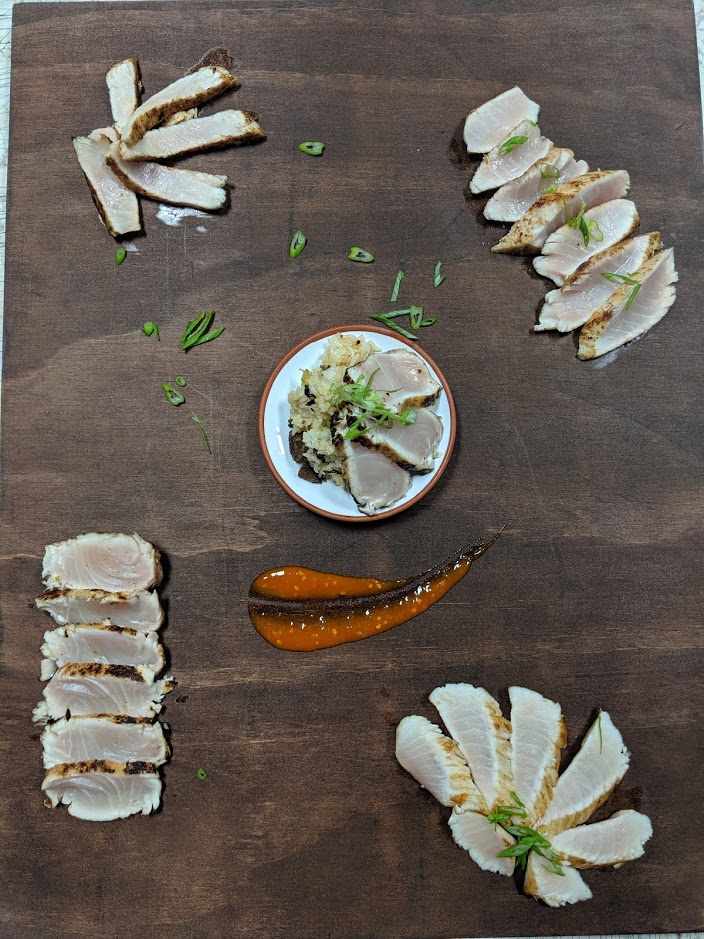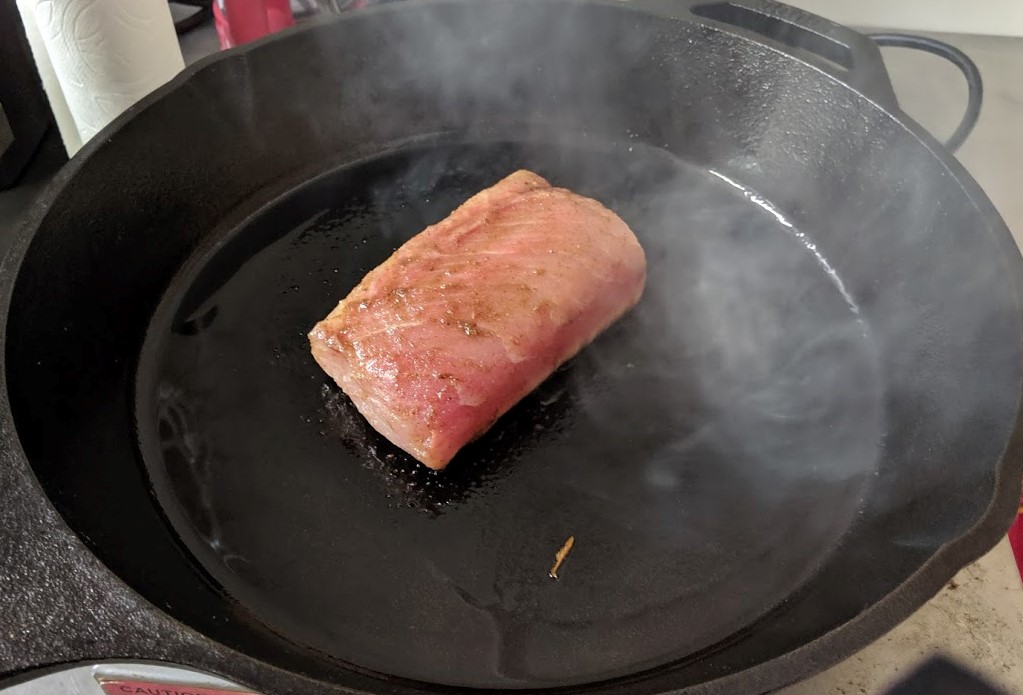
Rare Seared Louisiana Almaco
Chef Jason Demers
Serves 4 people
Ingredients:
-1.5lbs Filet Almaco Jack or other sashimi-grade fish
-6 oz Andouille Sausage, diced
-4 green onions, thinly sliced on a bias
-Your favorite Cajun seasoning
-Piri piri pepper sauce
-4 Cups white rice (I used Thai jasmine)
-Veggie oil
-Salt
-Pepper
Cookware:
-Cast Iron Skillet
-Pot with a lid, or rice cooker
-Sharp filet knife or sashimi knife
-Large cutting board
The fish:
Using a sharp filet knife, place the fish skin side down on your cutting board. With one hand, peel a small section of skin away from the meat to have a starting point. If you have a tail section, an easy way to filet the skin is to take a very small portion of the tail meat, just enough to have something to hold on to, and slide the knife between the meat and the skin.
Once skinned, it is important with sashimi grade fish to have as little of the oils from the outside of the skin to come into contact with the meat, so find a clean place on your cutting board, or flip it over so your meat is on a fresh surface. Next, find the line of bones along the middle and make two long cuts as close to the bones as you can, separating the filet the long way into two portions.
Then, examine the center where the bones met the skin, and make a cut along the length of the loin to remove the bloodline. Look for any rib bones or silver skin and remove any tough tendons you find. I like working with portions of meat about the size of a wide sushi roll. Rub down the cleaned portions with a bit of oil, salt, and Cajun seasoning.

In a hot cast iron pan, add in enough oil to barely cover the bottom when swirled around. I like to use non-canola veggie oil, not olive oil, since it has a higher smoke point and won’t change much of the flavor of the fish. Carefully place the fish into the pan. All we are looking for here is to get good sear and make a crust around the fish. If you look at the end of the piece of fish as it cooks, you want no more than a half a centimeter of white cooked fish around the edge.
If it is taking longer to get a good golden-brown sear on your fish, your pan is not hot enough. Once the fish is in the pan, it’s important not to move it around to get the best sear. Rotate the piece about every 45 seconds until all sides have a thin crust, and then place the fish on a clean cutting board to rest. The inside should be raw. Wait a few minutes, and then with a sharp knife slice the fish into thin, uniform pieces.
You don’t want to saw at the fish, but start with the very tip of the knife and try to make the cut with one smooth motion, where the base of the knife makes it through to the cutting board. This will make your cuts look cleaner.
The rice:
Make a batch of plain white rice on the stove or in a rice cooker, and set aside. While your fish is resting, wipe out the cast iron pan to remove any burnt bits of seasoning that may be in the bottom. Add a bit more oil, once it is nice and hot, throw in your diced Andouille sausage, get a sear on one side, and then add most of your sliced green onions. Sauté for a minute or so, being careful not to burn the onions, and then add in about 5 cups of cooked rice. Stir gently to mix the sausage and green onion evenly throughout the rice. Season with a bit of salt and more Cajun seasoning.
To serve:
Near one edge of the plate, out a circular dollop of piri piri sauce, and push a spoon through it to make a swoosh. Above that, make tall circular mounds of rice just off center of your plate, and stagger the sliced fish leaning against the rice. Garnish with sliced green onions.

*When eating raw fish, there are a few preparations to consider. It is good practice to freeze your fish for a few days to kill off any parasites present in the meat. The best portions for sashimi are the tops of the loin along the back. If you do not have time to freeze the fish, avoid eating the area neat the stomach, and inspect it well by holding the meat up to the light as you would if you were looking for a watermark in a dollar bill.
